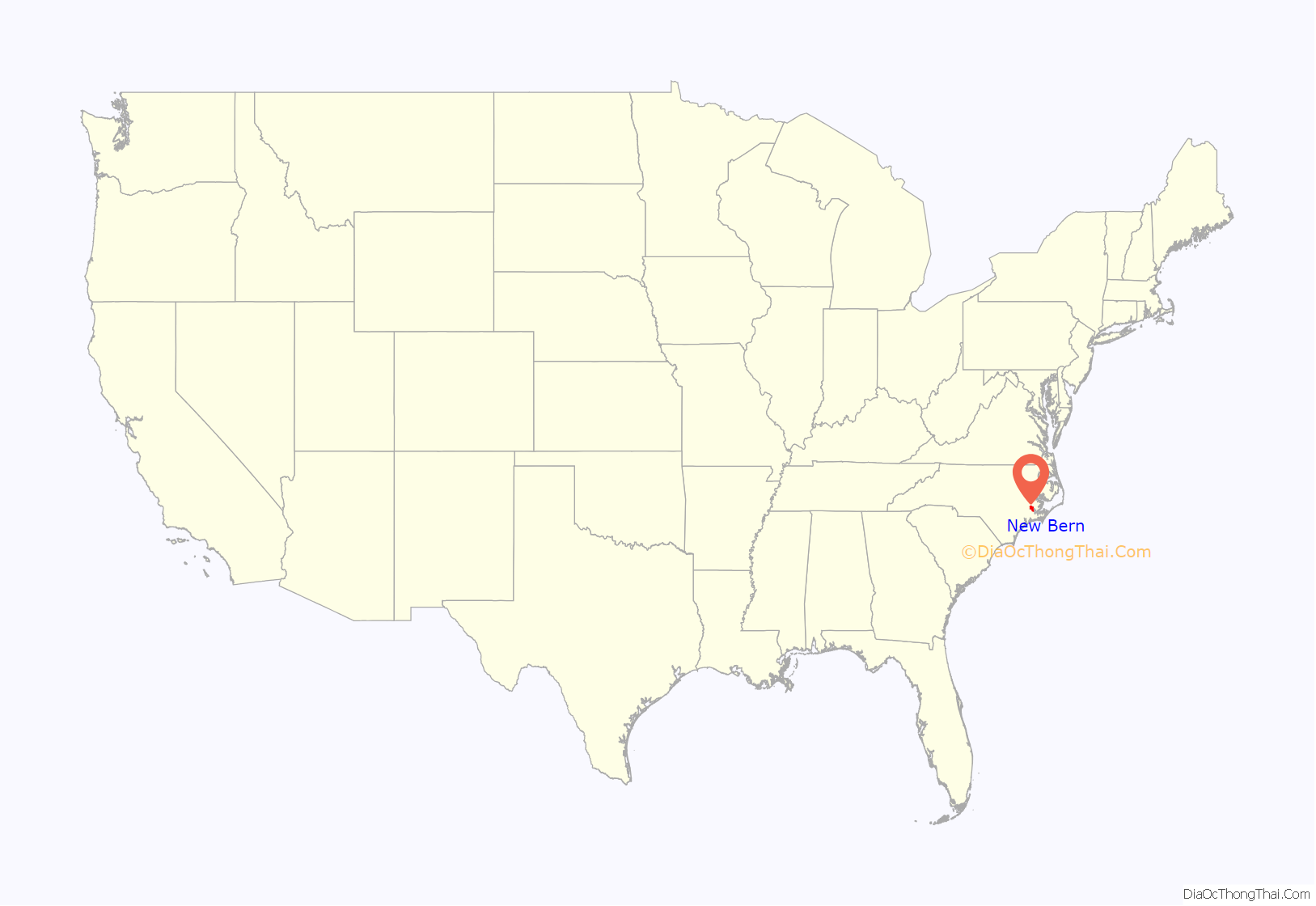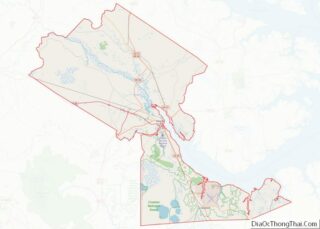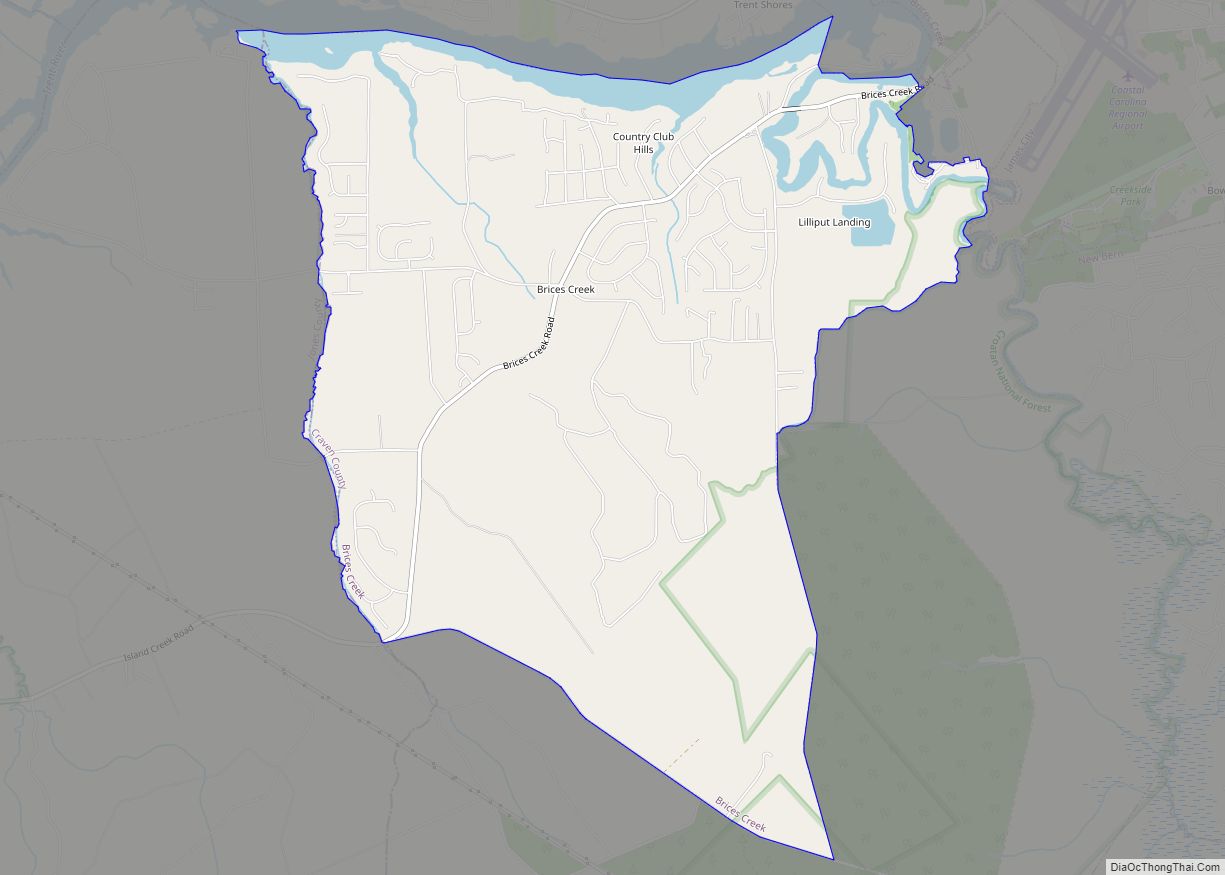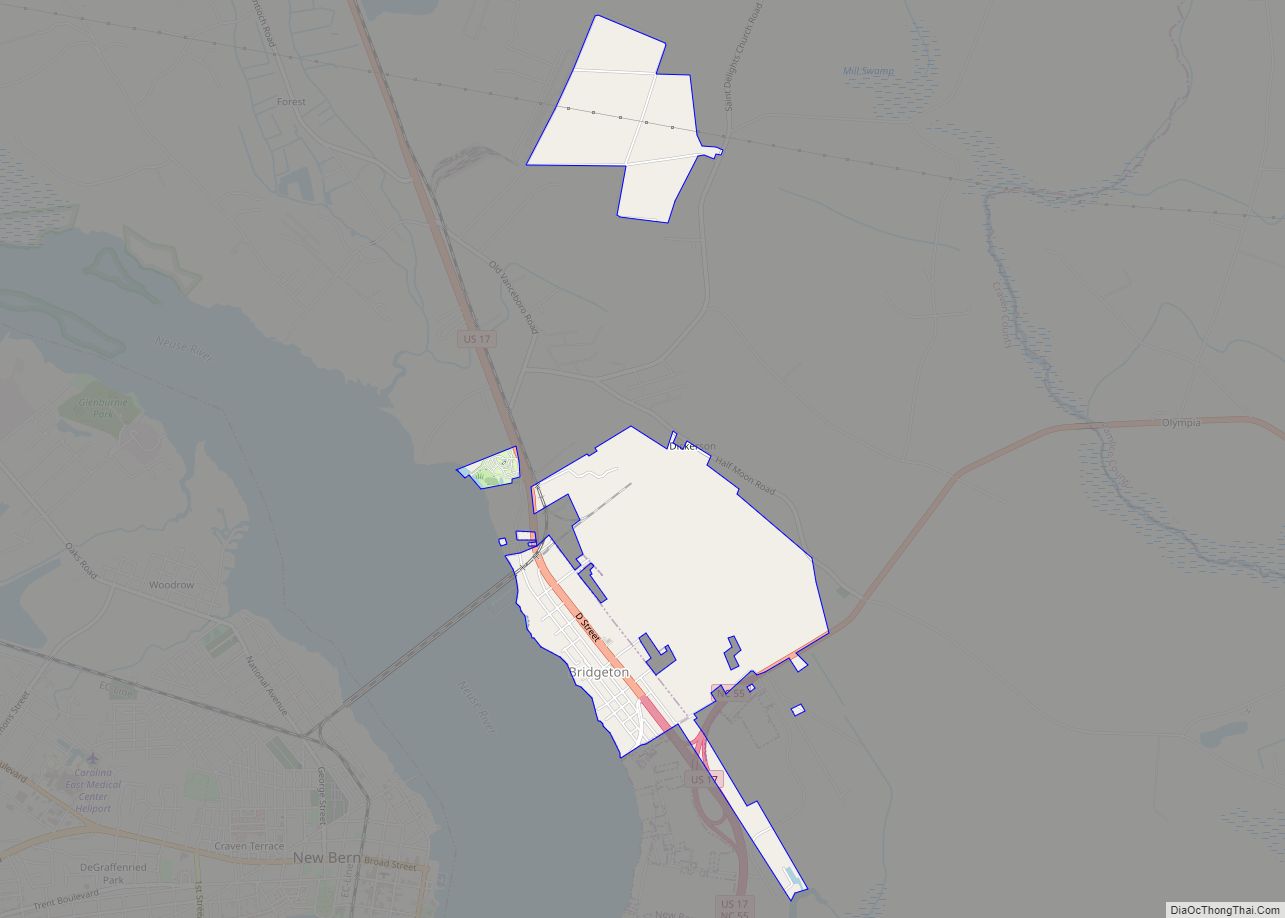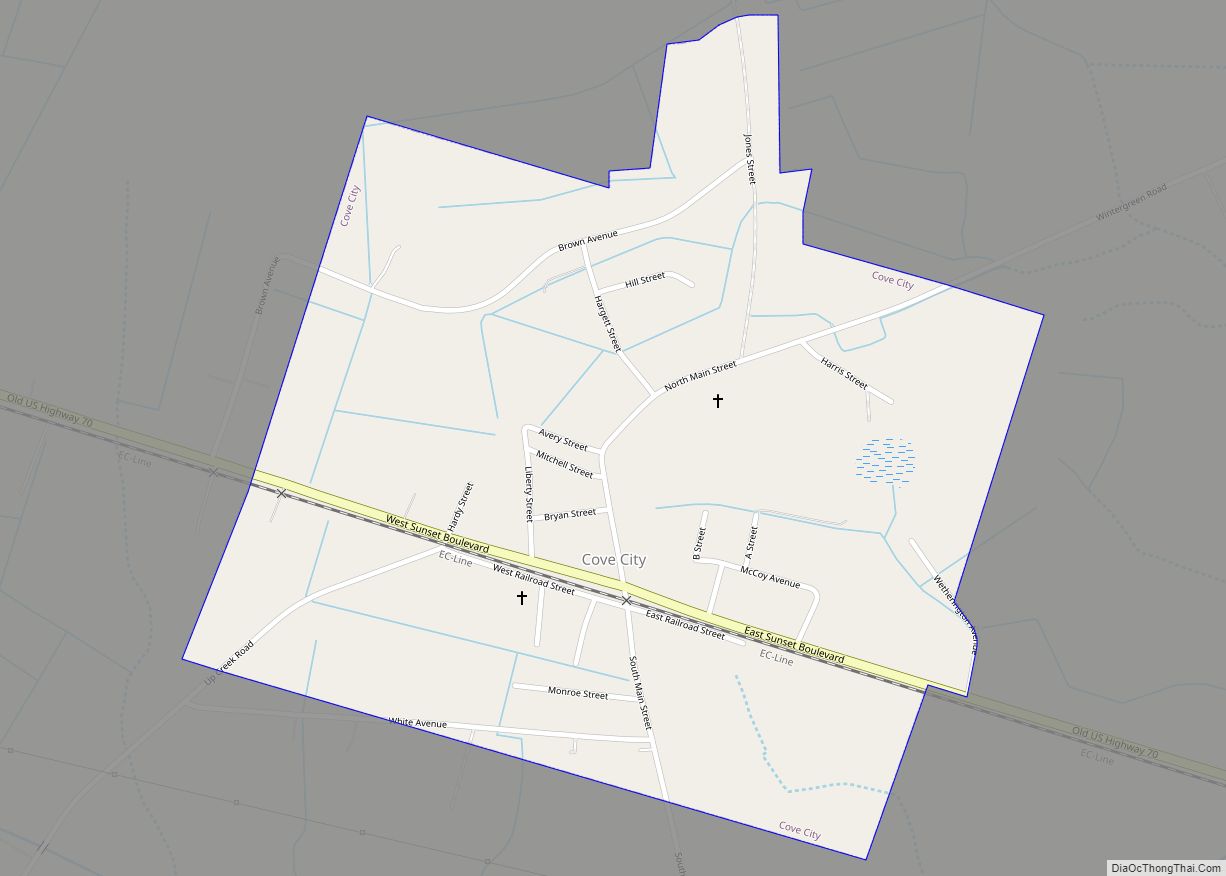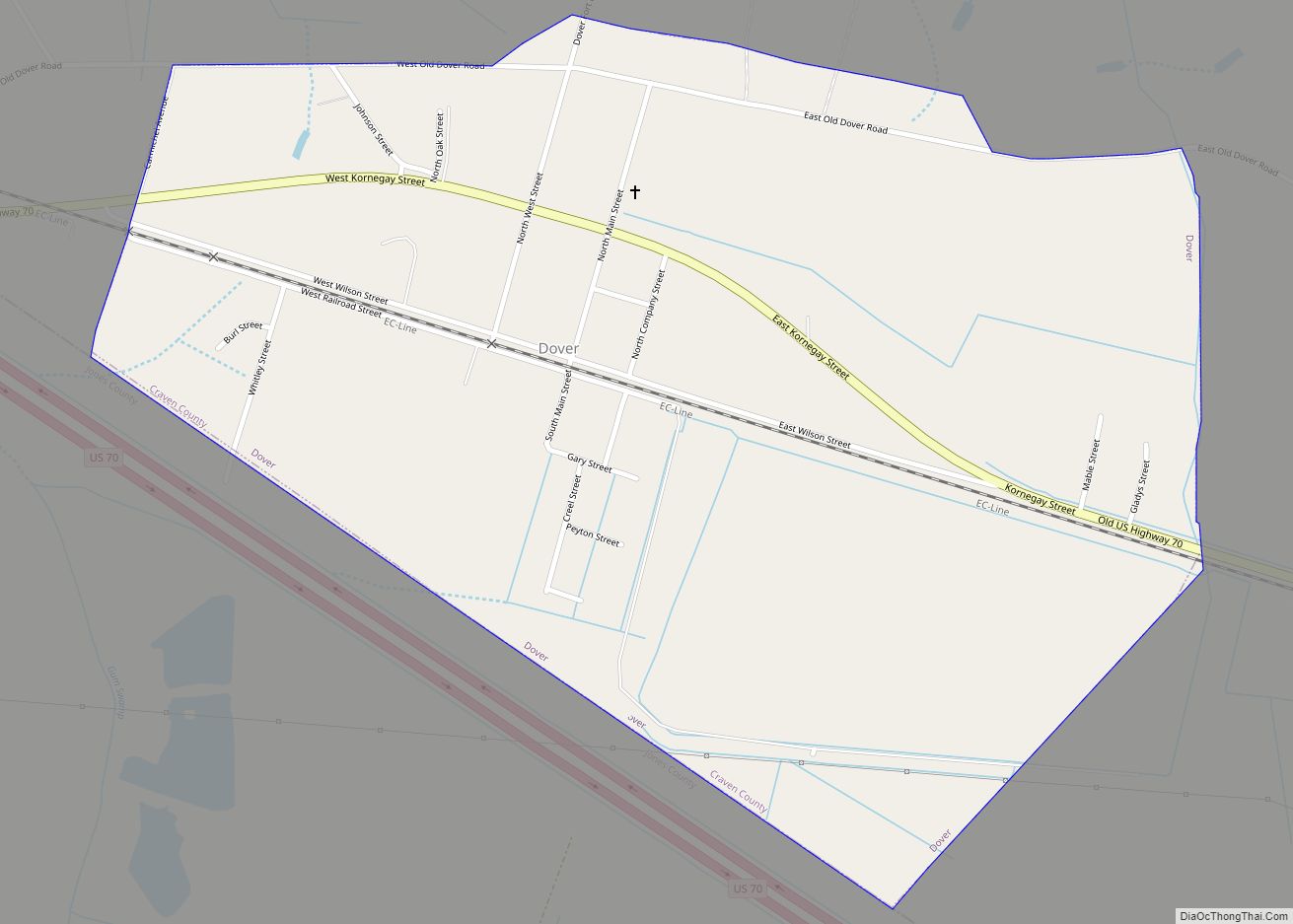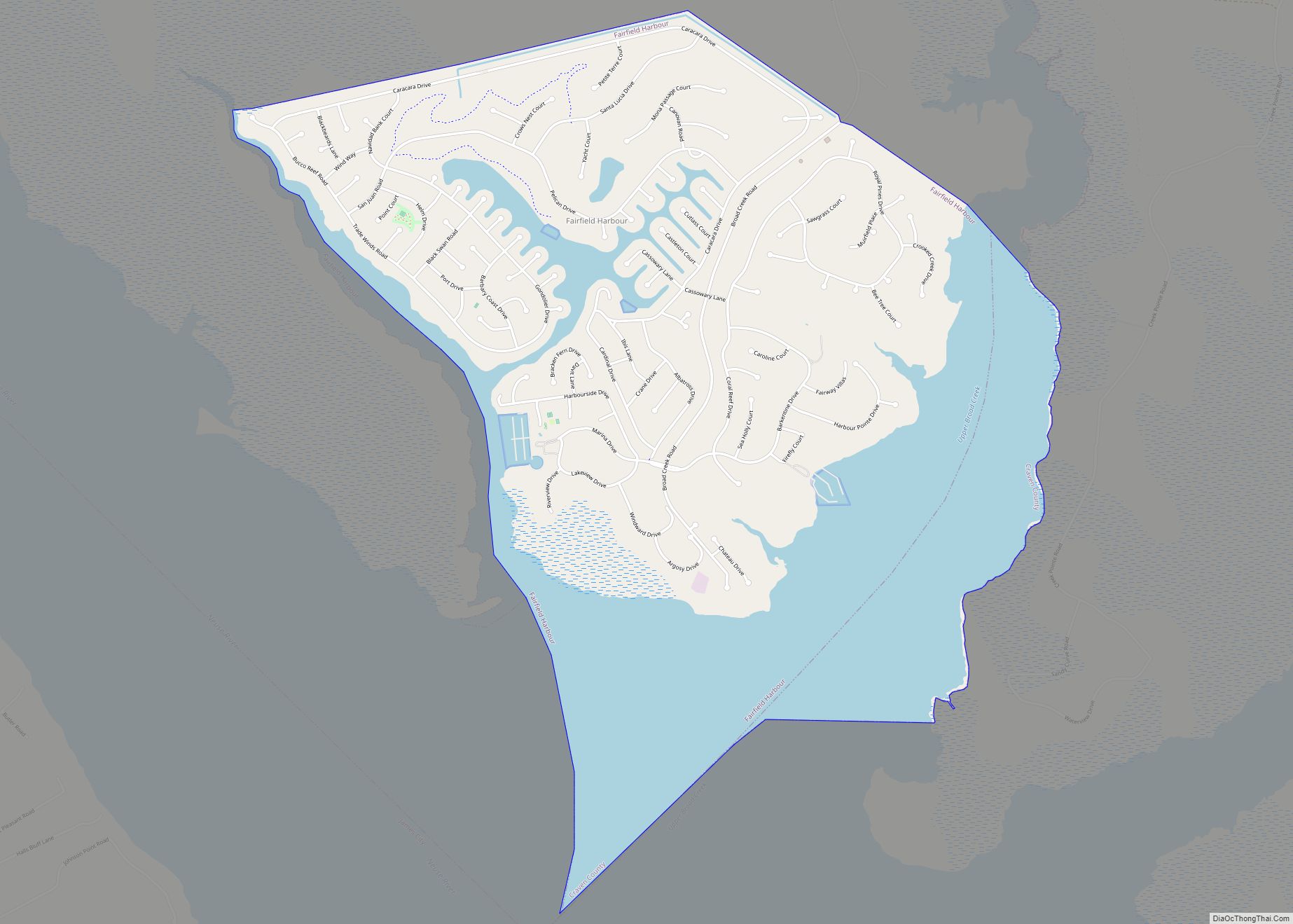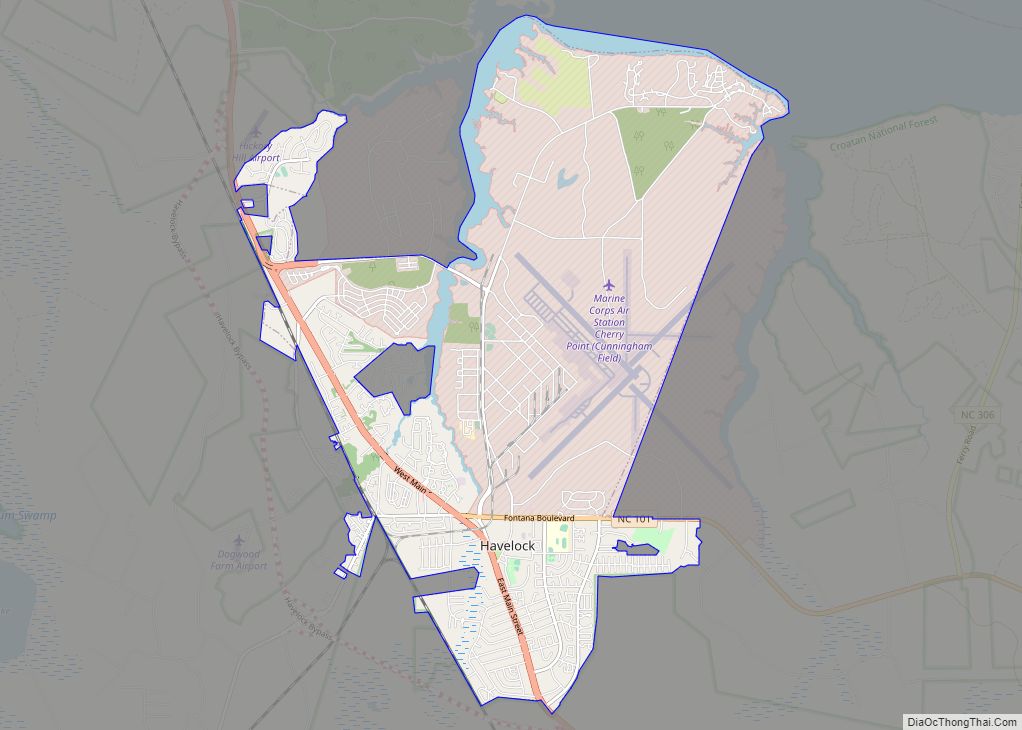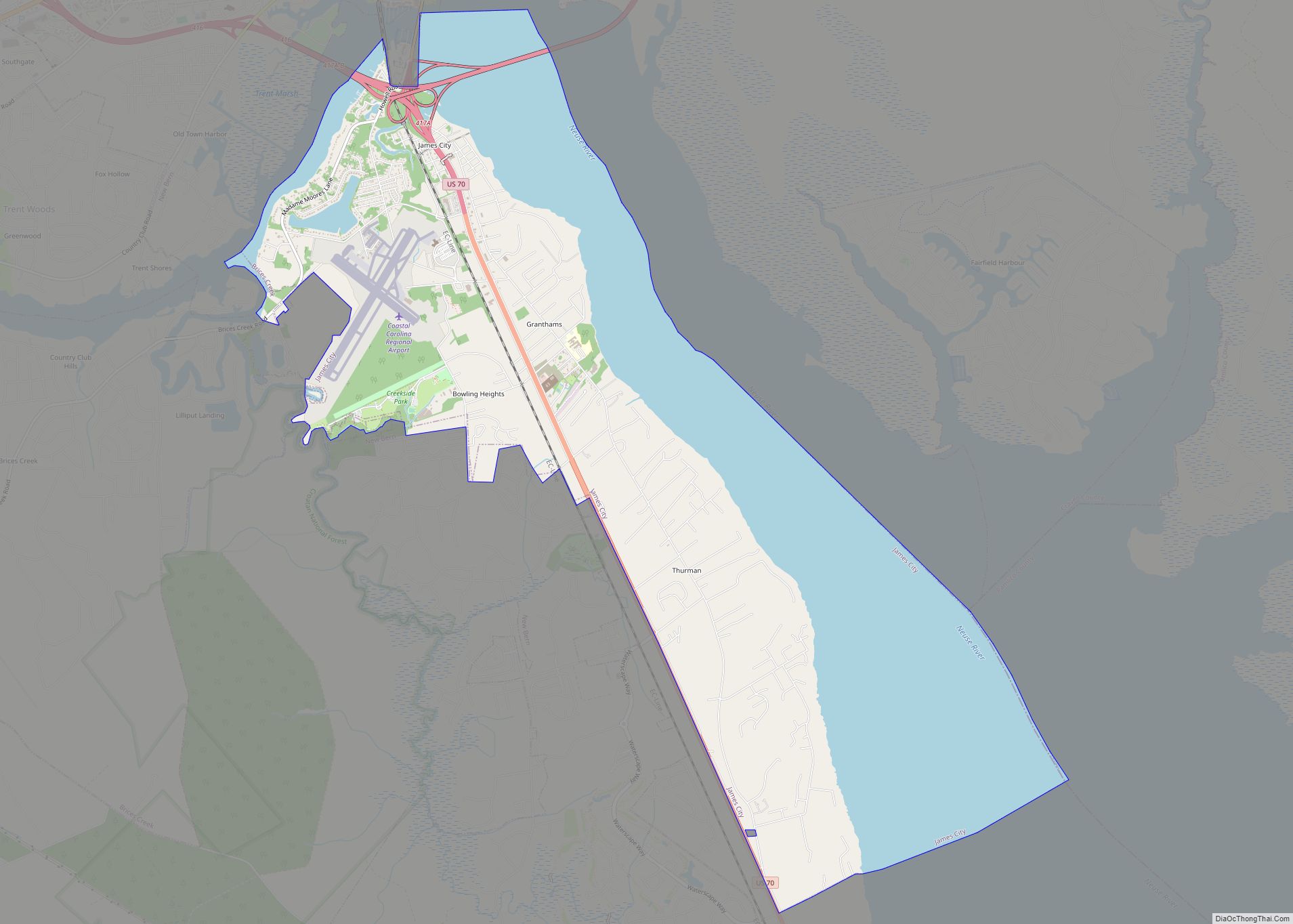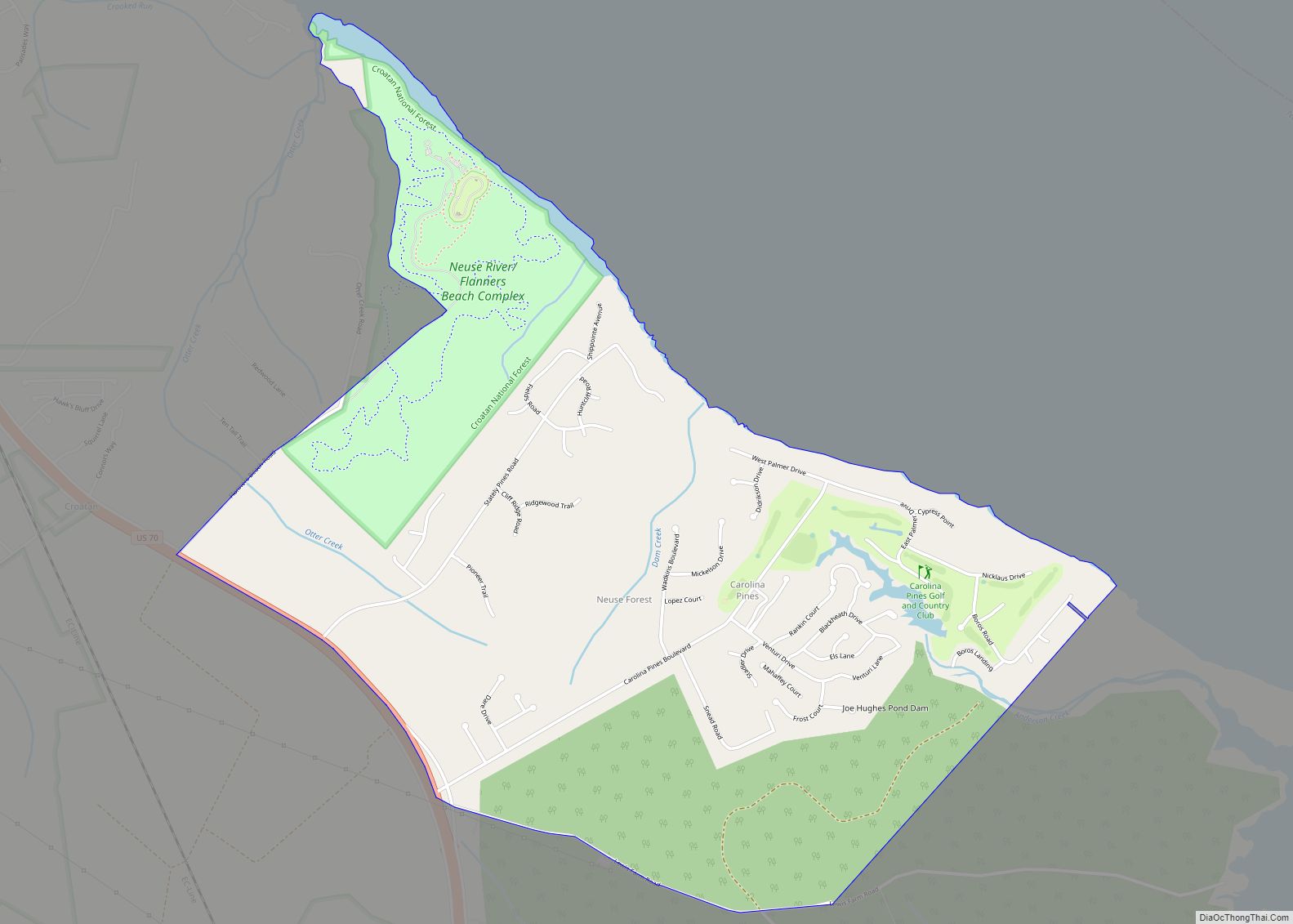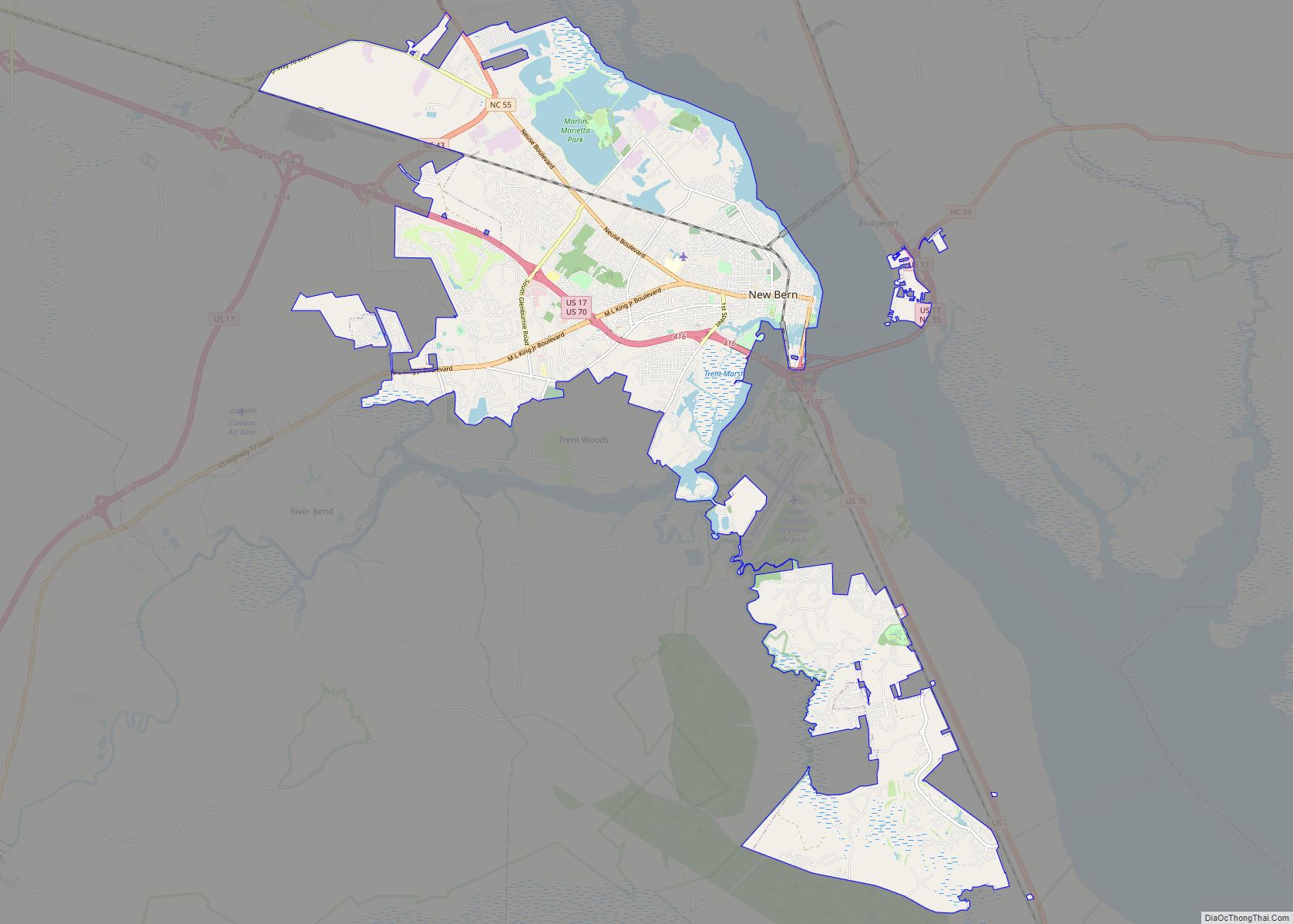New Bern, formerly called Newbern, is a city in Craven County, North Carolina, United States. As of the 2010 census it had a population of 29,524, which had risen to 31,291 people as of the 2020 census.
It is located at the confluence of the Neuse and the Trent rivers, near the North Carolina coast. It lies 112 miles (180 km) east of Raleigh, 80 miles (130 km) north of Wilmington, and 162 miles (261 km) south of Norfolk. New Bern is the birthplace of Pepsi.
New Bern was founded in October 1710 by the Palatines and Swiss under the leadership of Christoph von Graffenried. The new colonists named their settlement after Bern, the Swiss region from which many of the colonists and their patron had emigrated. The flag and arms of the American city are nearly identical to those of the Swiss canton. The English connection with Switzerland had been established by some Marian exiles who sought refuge in Protestant parts of Switzerland. There were also marriages between the House of Stuart and notable people in the history of Calvinism. The colonists later discovered they had started their settlement on the site of a former Tuscarora village named Chattoka. This caused conflicts with the Tuscaroras who were in the area.
New Bern is the second-oldest European settled colonial town in North Carolina, after Bath. It served as the capital of North Carolina from 1770 to 1792. After the American Revolution (1775–1783), New Bern became wealthy and quickly developed a rich cultural life. At one time New Bern was called “the Athens of the South,” renowned for its Masonic Temple and Athens Theater. These are both still very active today.
New Bern has four historic districts listed on the National Register of Historic Places; their numerous contributing buildings include residences, stores and churches dating back to the early eighteenth century. Within walking distance of the waterfront are more than 164 homes and buildings listed on the National Register. Also nearby are several bed and breakfasts, hotels, restaurants, banks, antiques stores and specialty shops. The historic districts contain many of the city’s 2,000 crape myrtles—its official flower—and developed gardens. New Bern has two “Local Historic Districts”, a municipal zoning overlay that affords legal protection to the exteriors of New Bern’s historic structures.
| Name: | New Bern city |
|---|---|
| LSAD Code: | 25 |
| LSAD Description: | city (suffix) |
| State: | North Carolina |
| County: | Craven County |
| Founded: | October 1710 (1710-10) |
| Elevation: | 10 ft (3 m) |
| Total Area: | 29.95 sq mi (77.56 km²) |
| Land Area: | 28.46 sq mi (73.70 km²) |
| Water Area: | 1.49 sq mi (3.86 km²) |
| Total Population: | 31,291 |
| Population Density: | 1,099.59/sq mi (424.56/km²) |
| ZIP code: | 28560, 28562 |
| Area code: | 252 |
| FIPS code: | 3746340 |
| GNISfeature ID: | 1013911 |
| Website: | newbernnc.gov |
Online Interactive Map
Click on ![]() to view map in "full screen" mode.
to view map in "full screen" mode.
New Bern location map. Where is New Bern city?
History
New Bern was settled in October 1710 by the Palatines and Swiss under the leadership of Christoph von Graffenried. The new colonists named their settlement after the Canton of Bern, home state of their patron. Bernberg had the original plat of the town laid out in the shape of a cross, though later development and additional streets have obscured this pattern within the regular street grid. The British governor’s palace (present-day Tryon Palace) served as the capitol of North Carolina from 1770 until the state government relocated to Raleigh in 1792, after a fire had destroyed much of the capitol. This became the first permanent capital city of North Carolina.
There was no printer in North Carolina until 1749, when the North Carolina Assembly commissioned James Davis from Williamsburg, Virginia to act as their official printer. Before this time the laws and legal journals of North Carolina were handwritten and were largely kept in a disorganized manner, prompting them to hire Davis. Davis settled in New Bern and was appointed by Benjamin Franklin as North Carolina’s first postmaster, who also became active in North Carolina’s politics, as a member of the Assembly and later as the Sheriff. Davis also founded and printed the North-Carolina Gazette, North Carolina’s first newspaper, printed in his printing house in New Bern.
During the 19th-century Federal period, New Bern became the largest city in North Carolina, developed on the trade of goods and slaves associated with plantation agriculture. After Raleigh was named the state capital, New Bern rebuilt its economy by expanding on trade via shipping routes to the Caribbean and New England. It was part of the Triangle Trade in sugar, slaves, and desired goods. It reached a population of 3,600 in 1815.
In 1862 during the early stages of the American Civil War, the area was the site of the Battle of New Bern. Federal forces captured and occupied the town until the end of the war in 1865. Nearly 10,000 enslaved blacks escaped during this period in the region and went to the United States Army (Union Army) camps for protection and freedom. The Union Army set up the Trent River contraband camp at New Bern to house the refugees. It organized the adults for work. Missionaries came to teach literacy to both adults and children.
After the January 1863 Emancipation Proclamation of U.S. President Abraham Lincoln, slaves within the Confederate States were declared free, but not those in the United States. His order carefully limited the Proclamation to those areas in insurrection, where civil government was not respected and his military authority, therefore, applied. Because of this proclamation, more freedmen came to the Trent River camp for protection. The Union Army appointed Horace James, a Congregational chaplain from Massachusetts, as the “Superintendent of Negro Affairs for the North Carolina District” on behalf of the Bureau of Refugees, Freedmen and Abandoned Lands. In addition to the Trent River camp, James supervised development of the offshore Roanoke Island Freedmen’s Colony, which was intended to be self-supporting. Beginning in 1863, a total of nearly 4,000 freedmen from North Carolina enlisted in the U.S. Colored Troops to fight with the Union Army for their permanent freedom, including 150 men from the colony on Roanoke Island.
Due to the continuous occupation by the Union Army, New Bern avoided some of the destruction of the war years. There was much social disruption because of the occupation and the thousands of freedmen camped near the city. Whereas the 1860 Census had shown a population of 5,432 (of which 3,072, or 57%, were black), the population had swollen by the end of the war to more than 20,000, mostly because of the influx of freedmen. Still, New Bern recovered more quickly than many cities after the war. By the 1870s the lumber industry was developing as the chief part of New Bern’s economy. Timber harvested could be sent downriver by the two nearby rivers. The city continued to be a center for freedmen, who created communities independent of white supervision: thriving churches, fraternal associations, and their own businesses. By 1877 the city had a majority-black population.
The state legislature defined the city and county as part of North Carolina’s 2nd congressional district which, as former plantation territory, held a concentration of the state’s black residents. They elected four blacks to the US Congress in the late 19th century. The state’s passage of a constitutional suffrage amendment in 1900 used various devices to disenfranchise black citizens. As a result, they were totally closed out of the political process, including participation on juries and in local offices; white Democrats maintained this suppression mostly, until after passage of federal civil rights legislation, including the Voting Rights Act of 1965, which provided for federal enforcement of constitutional rights.
By 1890 New Bern had become the largest lumber center in North Carolina and one of the largest in all of the South. During this time, as many as 16 lumber mills were running and employing hundreds of men from New Bern and the area. The competitive nature of the lumber barons, the abundance of lumber and craftsmen, led to the construction in New Bern of some of the finest homes in the South, many of which have survived. The lumber boom lasted until the 1920s. One by one the lumber mills went out of business. Today only Weyerhaeuser manufactures lumber in the area.
The city has four National Historic Districts and two local ones, which have helped preserve the character of the architecture. The Downtown Local Historic District is 368.64 acres (149.18 ha) or 0.576 square miles (1.49 km); the Riverside Local Historic District covers 51.94 acres (21.02 ha) or 0.081 square miles (0.21 km). Union Point Park borders the Neuse and Trent rivers.
Hurricanes
New Bern’s location near the Atlantic coast renders it subject to the effects of Atlantic hurricane seasons. For example, in the 18th century the town suffered severe damage in the Great Chesapeake Bay Hurricane of 1769. Other hurricanes such as Hurricane Ione in 1955 and Hurricane Floyd in 1999 (just as examples) have also caused significant flooding and damage.
In September 2018, Hurricane Florence made landfall in the United States just south of Wrightsville Beach, 88.4 miles southwest of New Bern. A storm surge up to 13.5 feet in addition to days of heavy rains severely flooded various parts of the town. [National Hurricane Center Storm Surge Inundation Map, Sept 13, 2018]
New Bern Road Map
New Bern city Satellite Map
Geography
New Bern is located at the confluence of the Trent and Neuse rivers, two tidal waterways, in North Carolina’s Inner Banks region.
According to the United States Census Bureau, the city has a total area of 29.7 square miles (76.9 km), of which 28.2 square miles (73.1 km) is land and 1.4 square miles (3.7 km), or 4.87%, is water.
U.S. routes 17 and 70 pass through the city, merging briefly as a four-lane expressway passing south of the city center. US 70 leads west 33 miles (53 km) to Kinston and southeast 35 miles (56 km) to Morehead City near the Atlantic Ocean. Raleigh, the state capital, is 112 miles (180 km) west via US 70. US 17 leads southwest 37 miles (60 km) to Jacksonville, and crosses the Neuse River on a new bridge to lead north 36 miles (58 km) to Washington.
Climate
New Bern experiences a humid subtropical climate typical of the Atlantic coastal plain. Summers are hot and humid, with frequent afternoon thunderstorms that account for much of the higher summer precipitation. Spring and fall are generally mild, with fall foliage occurring from late October to early November. Winters are relatively mild and drier than the remainder of the year, with infrequent snowfall.
See also
Map of North Carolina State and its subdivision:- Alamance
- Alexander
- Alleghany
- Anson
- Ashe
- Avery
- Beaufort
- Bertie
- Bladen
- Brunswick
- Buncombe
- Burke
- Cabarrus
- Caldwell
- Camden
- Carteret
- Caswell
- Catawba
- Chatham
- Cherokee
- Chowan
- Clay
- Cleveland
- Columbus
- Craven
- Cumberland
- Currituck
- Dare
- Davidson
- Davie
- Duplin
- Durham
- Edgecombe
- Forsyth
- Franklin
- Gaston
- Gates
- Graham
- Granville
- Greene
- Guilford
- Halifax
- Harnett
- Haywood
- Henderson
- Hertford
- Hoke
- Hyde
- Iredell
- Jackson
- Johnston
- Jones
- Lee
- Lenoir
- Lincoln
- Macon
- Madison
- Martin
- McDowell
- Mecklenburg
- Mitchell
- Montgomery
- Moore
- Nash
- New Hanover
- Northampton
- Onslow
- Orange
- Pamlico
- Pasquotank
- Pender
- Perquimans
- Person
- Pitt
- Polk
- Randolph
- Richmond
- Robeson
- Rockingham
- Rowan
- Rutherford
- Sampson
- Scotland
- Stanly
- Stokes
- Surry
- Swain
- Transylvania
- Tyrrell
- Union
- Vance
- Wake
- Warren
- Washington
- Watauga
- Wayne
- Wilkes
- Wilson
- Yadkin
- Yancey
- Alabama
- Alaska
- Arizona
- Arkansas
- California
- Colorado
- Connecticut
- Delaware
- District of Columbia
- Florida
- Georgia
- Hawaii
- Idaho
- Illinois
- Indiana
- Iowa
- Kansas
- Kentucky
- Louisiana
- Maine
- Maryland
- Massachusetts
- Michigan
- Minnesota
- Mississippi
- Missouri
- Montana
- Nebraska
- Nevada
- New Hampshire
- New Jersey
- New Mexico
- New York
- North Carolina
- North Dakota
- Ohio
- Oklahoma
- Oregon
- Pennsylvania
- Rhode Island
- South Carolina
- South Dakota
- Tennessee
- Texas
- Utah
- Vermont
- Virginia
- Washington
- West Virginia
- Wisconsin
- Wyoming
